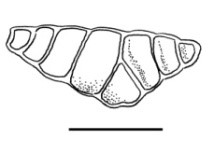Fungalpedia – Note 335, Triporicellaesporites (Fossil fungi)
Triporicellaesporites P. Ke & Z.Y. Shi
Citation when using this data: Saxena RK & Hyde KD. 2024 (in prep) – Fungalpedia, Fossil Fungi.
Index Fungorum, Facesoffungi, MycoBank, GenBank, Fig. 1
Classification: Fungi Incertae sedis, Staurosporae.
The fossil genus Triporicellaesporites was instituted by Ke & Shi (1978) from the Eocene-Oligocene (55.8–23 mya) sediments of Panshan, Liaoning Province, Coastal region of Bohai, China. The genus includes triangular-lenticular spores having triangular outline in polar view. Spores are triporate, with prominent pores situated at the corners of the triangle, which might be vestibulate. Spores are multicellular, cells in triangulate [triaxial?] arrangement. Spore wall is of medium thickness, surface psilate or provided with granulate to indistinct finely reticulate sculpturing. Kalgutkar & Jansonius (2000) emended the generic diagnosis as follows: “Pluricellate fungal spores with triangular to inverted V-shaped outline, with a central (stalked) hilum; the two lateral wings or appendages may be closed terminally, but commonly are preserved with the distalmost cells lacking; spore wall smooth”. This genus can be distinguished from all other genera of fossil fungal spores because its members are both multicellular and triporate and exhibit a triangular to chevron-shaped outline.
Type species: Triporicellaesporites triangulus P. Ke & Z.Y. Shi 1978.
Figure 1 – Triporicellaesporites triangulus. Scale bar = 5 μm. Redrawn from Ke & Shi (1978).
References
Ke P, Shi ZY. 1978 – Early Tertiary spores and pollen grains from the coastal region of the Bohai (in Chinese); Academy of Petroleum Exploration, Development and Planning Research of the Ministry of Petroleum and Chemical Industries and the Nanjing Institute of Geology, and Paleontology, Chinese Academy of Sciences, Kexue Chubanshe, Peking, 177 p.
Entry by
Ramesh K. Saxena, Birbal Sahni Institute of Palaeosciences, Lucknow, India
(Edited by Kevin D. Hyde, Samaneh Chaharmiri-Dokhaharani, & Achala R. Rathnayaka)
Published online 27 August 2024
